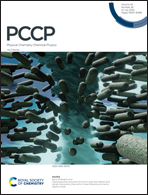Computational descriptor analysis on excited state behaviours of a series of TADF and non-TADF compounds†
Abstract
The thermally activated delayed fluorescence (TADF) behaviours of seventeen organic TADF emitters and two non-TADF chromophores bearing various donor and acceptor moieties were investigated, focusing on their torsion angles, singlet–triplet gap (ΔEST), spin orbit couplings (SOC) and topological ΦS index. Electronic structure calculations were performed in the framework of the Tamm–Dancoff approximation (TDA) allowing the possible reverse intersystem crossing (RISC) pathways to be characterized. The electronic density reorganization of the excited states was checked also with respect to the different exchange–correlation functional and absorption spectra were obtained by considering vibrational and dynamical effects through Wigner sampling of the ground state equilibrium regions. Examining all the parameters obtained in our computational study, we rationalized the influence of electron-donating and electron-accepting groups and the effects of geometrical factors, especially torsion angles, on a wide class of diverse compounds ultimately providing an easy and computationally effective protocol to assess TADF efficiencies.



 Please wait while we load your content...
Please wait while we load your content...